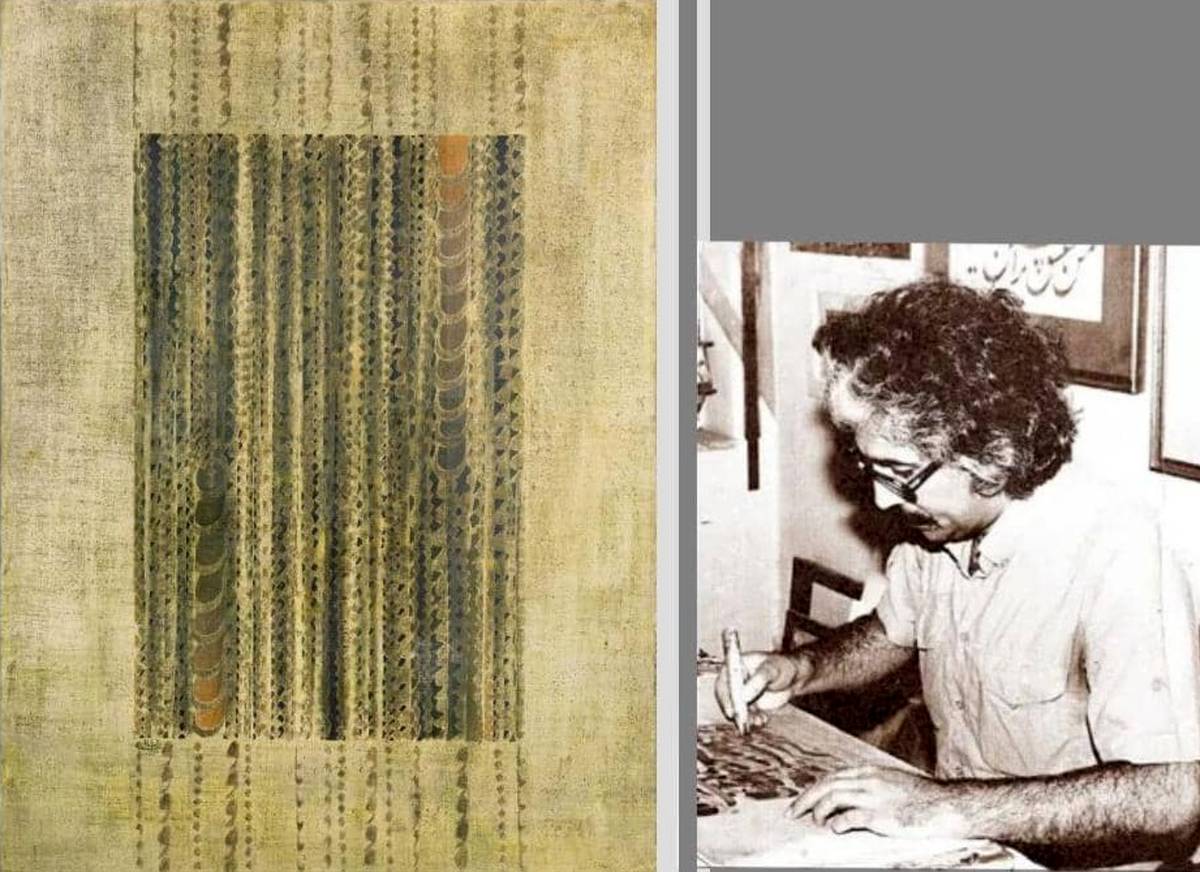
Raha Gallery Collection
Reza Mafi with a Half-Century-Old Work in Raha Gallery’s Collection
A unique work by Reza Mafi — a complex minimalist piece woven with Eastern-Iranian finesse — created nearly half a century ago, reflects the genius of an artist whose life lasted only 39 years.
ArtDayMe : The Middle East Raha Gallery Collection, Founded and directed by engineer Mohammadreza Ghaemmaghami, has been actively committed to cultural engagement in the region for over two decades. The collection preserves a rich array of modern and contemporary masterpieces by both Iranian and Arab artists.
Among them is an untitled piece by Reza Mafi, a pioneer of Iranian modernism.
This oil on canvas, measuring 75 × 100 cm, was created in 1974 (1353 in the Iranian calendar) and featured in the 3rd Tehran Auction in June 2014 (Khordad 1393).

Reza Mafi (1943, Mashhad – 1982, Tehran) was a renowned calligrapher and a pivotal figure in Iranian contemporary art. He is recognized as one of the first artists to explore calligraphic painting (Naqashi-Khat) in the modern era, significantly contributing to its development.
At the age of 18, Mafi moved to Tehran to study under master calligraphers. Alongside his studies, he practiced both calligraphy and painting. In 1964, he joined the classes of Hossein Mirkhani, a senior master at the Iranian Calligraphers’ Association. He later studied the styles of Mirza Gholamreza Esfahani, a famed Qajar-era calligrapher, diverging from the popular contemporary styles to embrace more traditional approaches.
Beyond his art, Mafi traveled to several Asian and European countries to study Eastern art and held successful exhibitions in France, Italy, and Switzerland in his youth.
Tragically, in October 1982, at the height of his artistic career, Mafi passed away at the age of 39 after falling from a horse during the filming of the renowned Iranian TV series Hezardastan.
This particular work, housed in the Raha Gallery Collection, is regarded as one of Mafi’s most distinctive pieces — straddling the line between Abstract Expressionism and Eastern Minimalism.
Amid muted tones and aged textures, Mafi — a pioneer of the Saqqakhaneh school — creates a world where script transcends writing, becoming a vessel of meaning.
The artwork before us exemplifies his endeavor to reconcile the traditions of Iranian calligraphy with the visual language of modernism — an abstract narrative of invocation, prayer, and perhaps even revelation.
The composition is built upon vertical order and rhythmic repetition, reminiscent of devotional rows, shrine curtains, or verses of sacred text. The cascading vertical script elements evoke a sense of descent or ascent, leaving interpretation to the viewer’s lived experience.
Mafi’s mastery in creating Siah-Mashq (practice calligraphy) is palpable. Though the texts are not legible, their presence is undeniable — as if meaning is cloaked behind layers of form.
This technique is not merely an aesthetic choice, but a conceptual statement: line as image, not information.

The earthy, olive, and brown hues, tinged with warm orange, lend a sense of serenity and stillness. A clever contrast between the warm tones and neutral background draws the viewer’s gaze to the center of the composition, where enigmatic forms are intricately interwoven.
Despite his short life, Mafi carved a unique place in the evolution of modern Iranian art. By drawing upon visual elements of Iranian-Islamic culture, he pioneered a new path — where script is no longer just a carrier of language, but a visual essence.
This piece embodies that vision — standing at the crossroads of silence and invocation, meaning and form.
At a time when contemporary artists increasingly turn to their cultural roots, revisiting Reza Mafi’s work becomes essential for understanding the trajectory of modern Iranian art — a path bridging past and future.
This artwork belongs to the Raha Gallery Middle East Collection.

LEAVE A RELPY